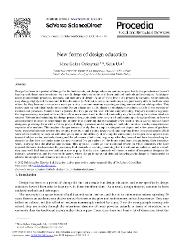| dc.contributor.author | Ozkaynak, Mine Gokce | |
| dc.contributor.author | Ust, Selin | |
| dc.date.accessioned | 2019-06-27T08:04:13Z | |
| dc.date.available | 2019-06-27T08:04:13Z | |
| dc.date.issued | 2012 | |
| dc.identifier.issn | 1877-0428 | en_US |
| dc.identifier.uri | https://hdl.handle.net/20.500.12469/909 | |
| dc.identifier.uri | https://doi.org/10.1016/j.sbspro.2012.08.133 | |
| dc.description.abstract | Design has been in a period of change for the last decade but design education and more specifically design educators haven't kept up with these transformations. As a result design students continue to learn outdated methods and techniques. A designer needs to understand processes methods and mediums of design. At all of these levels the process is the same while methods may change slightly and the medium differs dramatically. Without expertise in mediums a designer is only able to facilitate what others do | en_US] |
| dc.description.abstract | they become a means or a manager a step in communication repeating existing content without adding value. This makes such an individual easily replaceable. Design education usually places an emphasis on medium usually at the expense of methods and processes. Students learn a process but they quite often learn without comprehending. They are unable to negotiate the steps necessary to adjust to the realities of the environment and in the end that reality may be troubling for such an idealistic student. Without understanding the design process design students have no way of understanding a design problem or how to add constraints in order to better shape the problem into something that is manageable. We need to find a way to educate future designers providing them with a firmer grasp of design processes and a variety of methods - in other words comprehensive expertise of a medium. This implies a longer course of study than a simple undergraduate degree and a few years of graduate work | en_US] |
| dc.description.abstract | most professionals receive this training more by actually doing design work and skipping formal design education. While some of the inability to keep up with changes is due to the difficulty of revising the curriculum the largest issue appears to in terms of subject matter methods theory and the reluctance of educators to give up what they learned and have been teaching for decades so that they can make room for new material. Design students of the future must learn design during their formative years studying both the abstract and tactical. This approach challenges the traditional system in which educators who have repeated the same tired exercises for years may find themselves teaching something that it is without an audience and as a result they may well find themselves without a role to play. But the new approach will create a cadre of competent designers for industry government and the non-profit sector where design thinking and detailed knowledgeable design is fundamental to address the complex and dynamic qualities of our world. (C) 2012 Published by Elsevier Ltd. Selection and/or peer review under responsibility of Prof. Ayse Cakir Ilhan | en_US] |
| dc.language.iso | eng | en_US |
| dc.publisher | Elsevier Science Bv | en_US |
| dc.rights | info:eu-repo/semantics/openAccess | en_US |
| dc.subject | Design education | en_US |
| dc.subject | Methods of education | en_US |
| dc.subject | Curriculum development | en_US |
| dc.title | New forms of design education | en_US |
| dc.type | conferenceObject | en_US |
| dc.identifier.startpage | 140 | en_US |
| dc.identifier.endpage | 143 | |
| dc.relation.journal | Procedia - Social and Behavioral Sciences | en_US |
| dc.identifier.volume | 51 | en_US |
| dc.department | Fakülteler, Sanat ve Tasarım Fakültesi, İç Mimarlık ve Çevre Tasarımı Bölümü | en_US |
| dc.identifier.wos | WOS:000316256000025 | en_US |
| dc.identifier.doi | 10.1016/j.sbspro.2012.08.133 | en_US |
| dc.institutionauthor | Ozkaynak, Mine Gokce | en_US |
| dc.institutionauthor | Ust, Selin | en_US |
| dc.relation.publicationcategory | Konferans Öğesi - Uluslararası - Kurum Öğretim Elemanı | en_US |
















